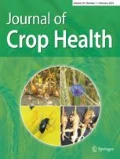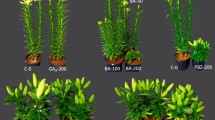Abstract
Lilies are one of the most important bulbous plants as cut flowers. In the present study, the effect of foliar sprays of different concentrations of benzyladenine (BA) (0.00, 0.25, and 0.50 mM) and salicylic acid (SA) (0.00, 0.10, 0.50, and 1.00 mM) was investigated at four stages of pre-harvest on qualitative and quantitative traits of Lilium ‘Navona’. The studied traits included number of buds, number of leaves, bud length, bud diameter, stem length, stem diameter, leaf length, leaf width, fresh and dry weights of stems and leaves, dry matter of stems and leaves, vase life, peduncle length and diameter, ionic leakage, chlorophyll index, content of anthocyanins, flavonoids, carotenoids and chlorophyll a, chlorophyll b, and total chlorophyll. The highest number of buds and vase life were achieved with 0.50 mM SA and 0.00 mM BA. The highest values for bud diameter and peduncle length were achieved with 1.00 mM SA and 0.00 mM BA, however, there was no significant difference to 0.50 mM SA. In addition, 0.50 mM SA increased stem diameter and length, leaf length and width, and stem fresh weight compared with control. Results showed that increasing BA to 0.50 mM caused undesirable effects on many traits including the number of buds. Since the largest number of buds and the highest vase life were achieved with 0.50 mM SA and 0.00 mM BA and these traits are the most important characters for the quality of Lilium, spraying of 0.50 mM SA is recommended.
Zusammenfassung
Lilien sind als Schnittblumen eine der wichtigsten Zwiebelpflanzen. In der vorliegenden Studie wurde die Wirkung von Blattdüngungen mit unterschiedlichen Konzentrationen von Benzyladenin (BA) (0,00, 0,25 und 0,50 mM) und Salicylsäure (SA) (0,00, 0,10, 0,50 und 1,00 mM) in vier Stadien vor der Ernte auf qualitative und quantitative Merkmale von Lilium ‚Navona‘ untersucht. Zu den untersuchten Merkmalen gehörten: Anzahl der Knospen, Anzahl der Blätter, Knospenlänge, Knospendurchmesser, Stängellänge, Stängeldurchmesser, Blattlänge, Blattbreite, Frisch- und Trockengewicht von Stängeln und Blättern, Trockenmasse von Stängeln und Blättern, Haltbarkeit in der Vase, Stiellänge und -durchmesser, Elektrolytverlust Chlorophyllindex, Gehalt an Anthocyanen, Flavonoiden, Carotinoiden, Chlorophyll a, Chlorophyll b und Gesamtchlorophyll. Die höchste Anzahl von Knospen und die längste Haltbarkeit in der Vase wurden mit 0,50 mM SA und 0,00 mM BA erreicht. Die höchsten Werte für Knospendurchmesser und Stiellänge wurden mit 1,00 mM SA und 0,00 mM BA erreicht, jedoch gab es keinen signifikanten Unterschied zu 0,50 mM SA. Darüber hinaus erhöhten 0,50 mM SA im Vergleich zur Kontrolle Stängeldurchmesser und -länge, Blattlänge und -breite sowie das Frischgewicht des Stängels. Die Ergebnisse zeigten, dass eine Erhöhung von BA auf 0,50 mM unerwünschte Auswirkungen auf viele Merkmale hatte, einschließlich der Anzahl der Knospen. Da die größte Knospenanzahl und die längste Haltbarkeit in der Vase mit 0,50 mM SA und 0,00 mM BA erreicht wurden und diese Merkmale die wichtigsten Charakteristika für die Qualität von Lilien sind, wird eine Besprühung mit 0,50 mM SA empfohlen.
Similar content being viewed by others
References
Arnon D (1967) Copper enzymes isolated chloroplasts, polyphenoloxidase in Beta vulgaris. Plant Physiol 24:1–15
Arteca RN (1996) Plant growth substances: principles and applications. Springer, Dordrecht, pp 1–311
Azhir S, Abad HHS, Mobasser HR (2015) The effect of acetylsalicylic acid and calcium chloride on the vase life of cut flower rose Samurai. Biol Forum 7(1):668–672
Benschop M, Kamanetsky R, Le Nard M, Okubo H, de Hertogh A (2010) The global flower bulb industry: production, utilization, research. Hortic Rev 36:1–115
Burchi G, Prisa D, Ballarin A, Menesatti P (2010) Improvement of flower color by means of leaf treatments in lily. Sci Hortic 125:456–460
Davis PJ (1988) Plant hormones and their role in plant growth and development. Kluwer, Dordrecht, p 432
Dhekney SA, Ashok AD, Rengasamy P (2000) Action of various regulators and floral preservatives on vase life of cut rose cv. First Red grown under controlled conditions. South Indian Hortic 48:69–71
Drazic G, Mihailovic N, Lojic M (2006) Cadmium accumulation in Medicago sativa seedlings treated with salicylic acid. Biol Plant 50(2):239–244
Elizabeth MA, Munne-Bosch S (2008) Salicylic acid may be involved in the regulation of drought-induced leaf senescence in perennials: a case study in field-grown Salvia officinalis L. plant. Environ Exp Bot 64:105–112
Ezhilmathi K, Singh VP, Arora A, Sairam RK (2007) Effect of 5‑sulfosalicylic acid on antioxidant activity in relation to vase life of gladiolus cut flowers. Plant Growth Regul 51:99–108
Gholian E, Danaee E, Oraghi Ardebili Z (2013) The effects of nanosilver application on the efficacies of different preservatives during the postharvest life gerbera cut flowers. Int Res J Appl Basic Sci 4(12):4342–4345
Han SS (2000) Growth regulators reduce leaf yellowing in Easter lily caused and spacing and root rot. J Hortic Sci 35:654–660
Han SS (2001) Benzyladenin and gibberlin improve postharvest quality of cut Asiatic and Orientalis lilies. Hortic Sci 36:741–745
Hassanpour Asil M, Roein Z, Abbasi J (2011) Response of tuberose (Polianthes tuberose L.) to gibberellic acid and benzyladenine. Hortic Environ Biotechnol 52:46
Hayat Q, Hayat SH, Irfan M, Ahmad A (2010) Effect of exogenous salicylic acid under changing environment. Environ Exp Bot 68:14–25
Ho LC (1988) Metabolism and compartmentation of imported sugars in sink organs in relation to sink strength. Annu Rev Plant Mol Biol 39:355–378
Hutchinson MJ, Chebet DK, Emongor VE (2003) Effects of accel, sucrose and silver thiosulphate on the water relations and postharvest physiology of cut tuberose flowers. Afr Crop Sci J 11:279–287
Kaijv M, Sheng L, Chao C (2006) Antioxidation of flavonoids of green rhizome. Food Sci 27:110–115
Kim JH, Lee AK, Suh JK (2005) Effect of certain pre-treatment substances on vase life and physiological character in Lilium spp. Acta Hortic 673:307–314
Krizek DT, Brita SJ, Miewcki RM (1998) Inhibitory effects of ambient level of solar UV‑B on growth of cv. New Red Fire Lettuce. Physiol Plant 103:1–7
Larqué-Saavedra A, Martin-Mex R (2007) Effects of salicylic acid on the bioproductivity of plants. In: Hayat S, Ahmad A (eds) Salicylic acid—a plant hormone. Springer, Dordrecht, pp 15–23
Lutts S, Kinet JM, Bouharmont J (1996) NaCl-induced senescence in leaves of rice (Oryza sativa L.) cultivars differing in salinity resistance. Annu Bot 78:389–398
Mutui TM, Emongor VE, Hutchinson M (2001) Effect of accel on the vase life and post harvest quality of alstroemeria (Alstroemeria aurantiaca l.) cut flowers. Afr J Sci Technol 2:82–88
Naor V, Kigel J, Ziv M (2005) The effect of gibberellin and cytokinin on floral development in Zantedeschia spp. in vivo and in vitro. Acta Hortic 673:255–263
Padmalatha TG, Reddy S, Chandrasekharc R, Shankard AS, Chaturvedie A (2014) Effect of pre-planting soaking of corms with chemicals and plant growth regulators on dormancy breaking and corm and cormel production in gladiolus. Int J Plant Animal Environ Sci 3(1):28–33
Paull RE, Chantrachit T (2001) Benzyladenine and the vase life of tropical ornamentals. Postharvest Biol Technol 21:303–310
Petridou M, Voylatzi C, Voylatzi D (2001) Methanol, ethanol and other compounds retard laef senescence and improve the vase life and quality of cut Chrysanthemum flowers. Postharvest Biol Technol 23:79–83
Preeti H, Gogoi S (1997) Effects of preplant chemical treatment of bulbs on growth and flowering of Polianthes tuberosa cv. single. Annu Biol 13:145–149
Ramadan T, Flowers TJ (2004) Effects of salinity and benzyladenine on development and function of microhairs of Zea mays L. Planta 219(4):639–648
Ranwala AP, Miller WB (2002) Effects of gibberellin treatments on flower and leaf quality of cut hybrid lilies. Acta Hortic 570:205–210
Serek M, Reid MS (1997) Use of growth regulators for improving the post-harvest quality of ornamentals. Perish Handl Q 92:7–8
Singh A, Kumar J, Kumar P (2008) Effects of plant growth regulators and sucrose on postharvest physiology, membrane stability and vase life of cut spikes of gladiolus. Plant Growth Regul 55:221
Skutnik E, Rabiza-Świder J, Łukaszewska AJ (2006) Evaluation of several chemical agents for prolonging vase life in cut asparagus greens. J Fruit Ornam Plant Res 14:233–240
Srivastava MK, Dwivedi UN (2000) Delaying ripening of banana fruits by salicylic acid. Plant Sci 158:87–96
Sugiura H (2004) Effects of 6‑benzylaminopurine and ethephon applications on flowering and morphology in summer-to-autumn-flowering Chrysanthemum under open field conditions. J Pestic Sci 29:308–312
Tavili A, Saberi M, Shahriari A, Heidari M (2013) Salicylic acid effect on Bromus tomentellus germination and initial growth properties under cadmium stress. J Plant Res 26:208–216
Wagner GJ (1979) Content and vacuole/extra vacuole distribution of neutral sugars, free amino acids, and anthocyanins in protoplast. Plant Physiol 64:88–93
William E (2001) Role of cytokinins in carnation flower senescence. Plant Physiol 59:707–709
Author information
Authors and Affiliations
Corresponding author
Ethics declarations
Conflict of interest
F. Abbasi, A. Khaleghi, A. Khadivi, and M. Solgi declare that they have no competing interests.
Rights and permissions
About this article
Cite this article
Abbasi, F., Khaleghi, A., Khadivi, A. et al. The Effect of Benzyladenine and Salicylic Acid on Morphological and Biochemical Traits of Asiatic Hybrid Lilium ‘Navona’. Gesunde Pflanzen 72, 219–225 (2020). https://doi.org/10.1007/s10343-020-00504-8
Received:
Accepted:
Published:
Issue Date:
DOI: https://doi.org/10.1007/s10343-020-00504-8




